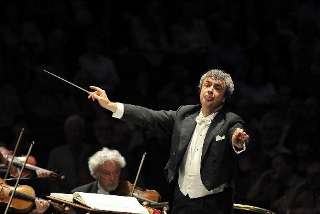|
Back
Love? Sorrow? It’s BOTH (and Neither) New York
Stern Auditorium, Carnegie Hall
11/30/2016 - & November 23, 24, 25 (Amsterdam), 29 (Washington), 2016
Detlev Glanert: Theatrum bestiarum (New York premiere)
Gustav Mahler: Symphony No. 5 in C-sharp minor
Royal Concertgebouw Orchestra, Semyon Bychkov (conductor)

S. Bychkov (© Chris Christodoulou)
“We are going to live forever!”
Gustav Mahler (played by Robert Powell) exclaiming the last line of the Ken Russell film Mahler
Programming a Mahler symphony can create a problem for a conductor or an orchestra manager. If it is the 1st or the 4th then one can put another substantial work on the program. If the 3rd or the 8th, then no other piece of music is required. However, if the symphony is the 7th or the 5th, then what does one do about intermission? These pieces are long symphonies, but not quite lengthy enough for an entire evening. So maestros have to get creative. Once Leon Botstein offered the piano transcription of the first movement of Mahler’s Song of the Night, which the composer had recorded as a piano roll, as a “first act” before the work as a whole, allowing the audience the respite of an intermission. At the Academy of Music in Philadelphia some years ago, Sir Andrew Davis presented the 5th with the curtain raiser Brigg Fair by Frederick Delius, a fifteen minute work that led into a twenty-five minute interval.
On Wednesday evening Semyon Bychkov solved the problem by opting for a relatively short modern piece that just seemed long. Theatrum bestiarum is a kind of Carnival of the Animals on steroids. Actual attempts at instrumental conjuring of animal noises and very, very loud utterances made up the bulk of this pastiche, as well as quotes from Berg, Shostakovich and Mahler. Mr. Glanert was on hand for a bow at the conclusion.
The performance of the Mahler was, alas, quite disappointing. The huge ensemble – there were no less than ten basses on view – lacked the two key elements of tension and attention and played as if tired or semisomnambulistic. Further, there was a sense that maestro Bychkov simply did not “feel it” when he did not put his arms down after the first movement and appeared to be ready to launch the second with only the slightest of pauses (a technique that significantly increases the drama of the piece) but demurred when the crowd erupted in a momentous coughing and fidgeting fit. The final hammer blow to the skeleton of this performance was that a telephone began ringing during the second movement. Now Carnegie Hall has been nothing if not diligent about educating their public to turn off their cellular devices, but this time the intrusion came from either the stage or backstage! It lasted long enough to be a severe breaker of mood.
What a waste! This marvelous instrumental ensemble simply had a classic bad night. The third movement features the solo horn and he did quite well, presenting a lyrical singing line. Alas, his mates in the section gave him little support, slurring and misspeaking on a regular basis. The remarkable Adagietto for strings and harp that is the fourth movement is a heartfelt memory with the emotions of love and loss intertwined. After three movements dominated by loud brass we feel safe in the arms of pure string sound. This quiet, thoughtful rhapsodizing kept Mahler’s music alive as a standalone piece in the dark days of the 1920’s through 1950’s when his music was only performed by a few dedicated friends and associates.
The movement was written as a love song for Alma Schindler, who would have easily recognized the quotations from Tristan und Isolde, but who also was aware enough to understand the combination of love and sorrow which is, in the final analysis, the essence of Mahler. There has been an amusing controversy over the past seventy years as to whether this movement is a love song or a dirge and an individual conductor often makes a choice in his selection of tempi and phrasing that identifies him with one camp or the other. Leonard Bernstein, the great popular champion of Mahler’s music and the individual most responsible for his acceptance in America today, weighed in heavily on the funereal side when he conducted the piece on television after the death of Robert Kennedy. Actually there should be no argument as this profound statement is both a love song and a dirge. As a memory the Adagietto is the quintessence of the bittersweet and its combination of love and decay made it the perfect accompaniment to Lucchino Visconti’s image of Aschenbach in the film Death in Venice (there is even a line of scholarship that sees Mahler as the model for Mann’s tragic hero). Neither amorous nor tragic, this Concertgebouw version was simply too fast to fully enunciate one position or the other.
If the fourth movement is a Klimt painting, then the fifth is the Beethovenfries at the Secession Haus, a huge, all-encompassing canvas that envelopes an entire floor (and which has Mahler as one of the smaller characters). Cleverly opening with the solo horn again, the movement, longer than the entire Glanert essay, turns kaleidoscopic, but suffers, even in the best of performances, from ancient mariner disease, a loquaciousness that can be irritating. This condition plus a sense that Wednesday night saw not their best effort made the work seem even longer than its 75 minutes. Pity.
So our recent Carnegie Hall exploration of Mahler’s “middle period” comes to an end. While conceiving of his 5th symphony, the already well-known composer went to study harmony and counterpoint with Alexander von Zemlinsky (while the teacher was most likely chatting up Alma). There is a more traditional bent to these three monumental canvasses than in either the symphonies written before or after, although the “cleansing process” did not rein in Mahler’s superb creativity.
Fred Kirshnit
|